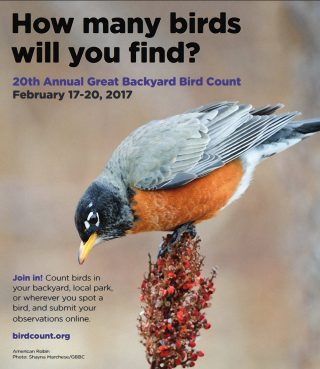
This is one of two GBBC 2017 posters available at http://gbbc.birdcount.org/news/poster/ for downloading and printing. The American Robin is the tenth most numerous bird found in the United States according to last year’s GBBC.
02/17/2017 – How Many Birds Will You Find?
It is that time again. It is time for the GBBC: the Great Backyard Bird Count! For four days in February every year, volunteers from around the world go out and count birds. This year the count will take place from Friday, February 17th through Monday, February 20th.
The general idea is to look for birds in your own backyard, but it is not restricted to that single locale. Anywhere you can find birds will work: From backyards to “parks, nature centers, school grounds, on hiking trails, balconies and beaches.”
By identifying the different species of birds present in an area, and tallying up their numbers, we get a handle on how healthy the populations are. As climate changes, this index of the stability of different species is vital information. Each checklist submitted is a snapshot of bird distribution. Each year’s checklists are contributing to a 20-year database that is helping us understand, protect, and manage the 8,600 or so bird species that inhabit planet Earth.
The checklists are also providing clues to the movements of birds on a year-to-year basis. Many species move from place to place with the seasons. Some migratory birds travel from one region to another, often thousands of miles. Other species partially draw back from their breeding grounds in the fall, and depending on how severe the winter, move only as far as necessary. This is proving to be true for waterfowl and kingfishers this year. They are finding open water further north this winter, and thus are not going as far south as they have in previous years.
Some species may be following food sources. A case in point is the American Robin. This widely distributed species breeds as far north as the Arctic Circle. Robins summer and winter throughout most of the United States. Large flocks of robins occur in Texas during most winters, if food is plentiful. Robins love berries, especially in winter, and in the southern states they feast on yaupon (Ilex sp.) fruits. American Robins are the tenth most numerous species reported during the GBBC. Almost every checklist submitted from the US reports robins.
We have been seeing dozens of robins in the eastern part of Bee County (where yaupon is abundant) for the past few months. Ironically, none of our local birders reported American Robins for the 2016 GBBC. Will they be on the 2017 count? It may depend on you.
Anyone can participate. It is as easy as 1, 2, 3. Step one: Register for the count. If you are an eBird user, or if you participated last year, then you are already registered. You just use your existing login name and password. If you are new to the GBBC, then you need to create an account at www.gbbcbirdcount.org
Step two: Count birds for at least 15 minutes on one or more days of the GBBC. You can count for longer than that if you wish! Count birds in as many places and on as many days as you like—one, two, three, or for all four days. Submit a separate checklist for each new day, for each new location, or for the same location if you counted at different times of the day. Estimate the number of individuals of each species that you saw during your count period.
Step three: Enter your results on the GBBC website by clicking on “Submit Observations” on the home page. If you already participate in the eBird citizen-science project, please use eBird to submit your sightings during the GBBC. Your checklists will count toward the GBBC.
In addition to counting birds, the GBBC photo contest has been a hit with participants since it was introduced in 2006. Thousands of stunning images have been submitted since then. For the 20th Anniversary of the count, the public is invited to vote for their favorite top photo from each of the past eleven years in a special album on the website. Voting takes place during the four days of the GBBC.
If you are previous GBBC participant, please continue to contribute. If you are new to the idea, give it a shot! It’s fun, it’s free, and it helps birds! What’s not to like?
This is the twentieth year for the Great Backyard Bird Count. The first count was in 1998. “The very first GBBC was an experiment,” recalls Marshall Iliff, director of the eBird project at Cornell’s Laboratory of Ornithology. “We wanted to see if people would use the Internet to send us their bird sightings. Clearly, the experiment was a success!” That first year, birdwatchers in the United States and Canada submitted over 13,500 checklists during the four-day event.
The Great Backyard Bird Count is now a global event. Last year, the 19th annual GBBC received more than ten times as many checklists from over 100 countries around the world. And on this 20th anniversary count, even more participants from more countries are expected to contribute checklists. Will you be one of participants? How many birds will you find?
If you would like to offer comments, please click through to the discussion page
